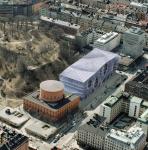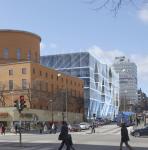Site and Context
The Aplund building is one of Stockholm’s important architectural landmarks and connecting to such a building requires attention at all scales. The new building leans forward to touch the Asplund library making a significant and noticeable yet respectful connection between old and new.
Hanging Structural System
When looking for intelligent structural solutions we sought to use the inherent structural logic of the library – the bookshelf. Instead of creating a building and filling it with book structures (shelves) why not use the book structures as a building structure? This programmatic structure combined with the site constraint led to the development of the overall structure: eight large cores support a three-meter high space frame. Off of this preliminary structure a dense grid of 1x2 meter steel cables is suspended. This grid extends throughout the building to support everything from the façade to the book shelves. The cores shift from their original grids to keep a six meter distance from the subway tunnel below grade.
Programmatic Distribution & Structural Typology
The library serves three types of occupants - media & books, the public and the library staff. Each of these occupant groups has a unique spatial typology and functional needs. The heart of the library is the mass of book storage areas located from the third to sixth floors of the new building as well as in the main rotunda of the Asplund building. The density of the grid allows us to minimize the diameter of rods creating a delicate lattice of supporting structure throughout the building. The public reading halls are large-span inserted spaces within the mass of book stack areas creating dramatic 2-3 floor high cathedrals for reading. Offices are cantilevers off the west facade. The ground floor and the first and second floors of the new building house the public spaces.
.jpg)
.jpg)


